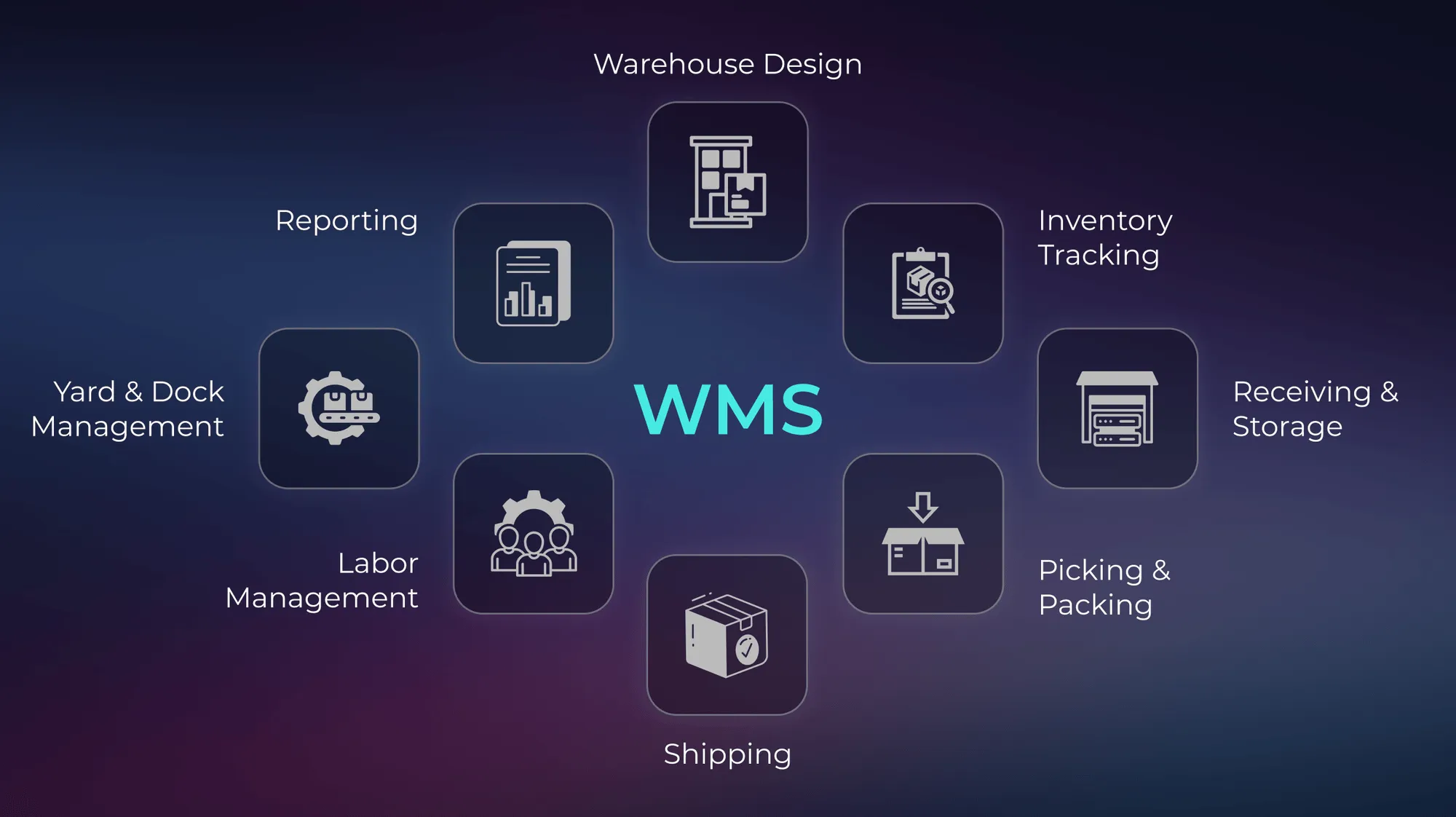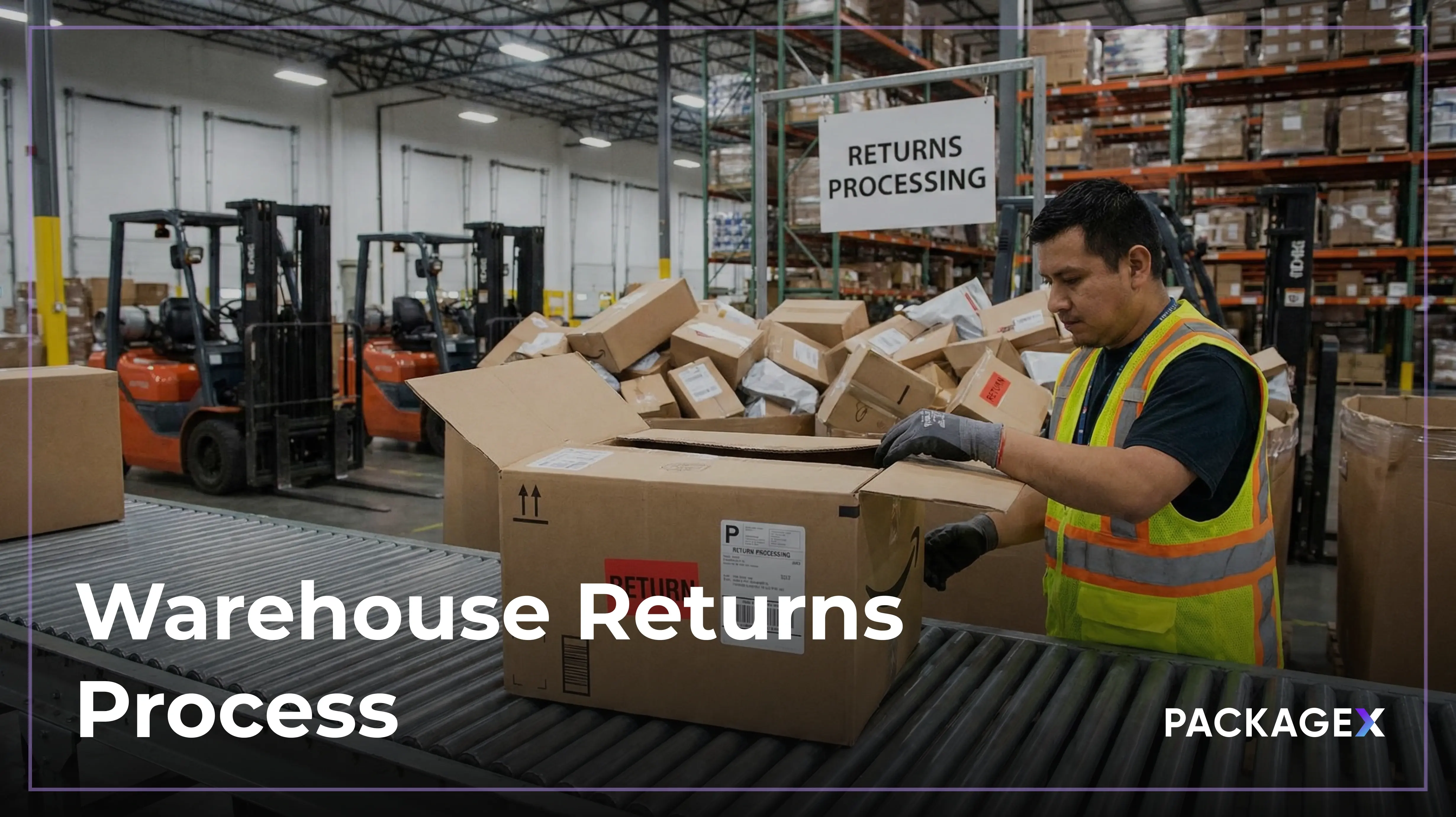The global warehouse automation sector is forecasted to be worth more than $54.6 billion by 2030, according to industry estimates. These stats highlight how fast companies are moving towards smarter logistics. At the center of this evolution is the warehouse management system (WMS).
So, what is a warehouse management system?
A warehouse management system (WMS) is software that controls and optimizes warehouse operations. It tracks inventory, orchestrates daily operations, and ensures goods move smoothly from receipt to shipping. By minimizing mistakes and increasing efficiency, it transforms a potentially disorganized environment into a well-coordinated logistics hub.
Key Features of Warehouse Management System
Here are the main features of a Warehouse Management System (WMS):
- Warehouse Design: Customizes workflows and picks logic for optimized inventory allocation.
- Inventory Tracking: Uses RFID and barcode scanning for real-time stock visibility.
- Receiving and Storage: Efficient inventory storage with technologies like pick-to-light.
- Picking and Packing: Supports zone, wave, and batch picking methods for efficient order fulfillment.
- Shipping: Automates shipment paperwork and notifications.
- Yard and Dock Management: Helps drivers find loading docks and supports cross-docking. Basically, a warehouse management system is a standard system designed to support cross-docking.
- Reporting: Tracks warehouse performance for continuous improvement.
What Does a Warehouse Management System Do?
A warehouse management system (WMS) is essential software for streamlining all warehouse operations from inbound logistics to outbound deliveries.
Core Functions of a Warehouse Management System
1. Inventory Management
A warehouse management system offers real-time insights into inventory levels, ensuring accurate warehouse tracking and minimizing the chances of stockouts or excess inventory. With features like cycle counting and inventory forecasting, it enables continuous auditing without disrupting daily operations..
2. Order Fulfillment
The system automates the entire order process, from receiving to picking, packing, and shipping, ensuring more accurate order fulfillment. The best WMS software also manages last-mile delivery readiness by ensuring orders leave the warehouse correctly labeled, documented, and tracked.
3. Labor and Workflow Optimization
Through built-in task management, a WMS enhances labor allocation across the warehouse. It assigns tasks based on availability, proximity, and skills while tracking performance metrics to optimize staffing levels and reduce operational costs.
4. Receiving and Putaway
The system enhances inbound logistics by streamlining the receiving process. It guides where and how goods should be stored, improving space utilization and reducing the time needed for putaway. Barcode scanning and mobile devices often integrate via API connections to ensure accuracy and speed.
5. Reporting, Analytics, and Visibility
WMS platforms generate actionable reports and real-time dashboards that provide operational insights. These analytics help monitor key KPIs and support smarter decision-making.
6. System Integration and Technology Enablement
A warehouse management system typically integrates with ERP systems and TMS platforms to ensure seamless data exchange across procurement, fulfillment, and shipping processes. Advanced systems are now utilizing blockchain technology to enhance traceability and data integrity throughout the supply chain.
What Is a Cloud WMS?
A cloud-based warehouse management system (WMS) is hosted online, enabling businesses to manage their operations from anywhere with internet access. Unlike on-premise WMS solutions, which require heavy upfront costs for hardware and maintenance, cloud WMS is subscription-based, offering lower initial costs and quicker deployment.
Advantages of Cloud WMS
- Scalability: Easily adapts to growing or seasonal needs.
- Accessibility: Operable from any connected device, enhancing flexibility.
- Lower Operational Costs: Eliminates IT maintenance and reduces energy costs.
- Seamless Integration: Compatible with various ERP and logistics systems.
- Enhanced Security: The provider manages security, often utilizing industry-standard protocols.
What are the Types of Warehouse Management Systems?
Choosing the right warehouse management system depends on your business goals, budget, and operational complexity. There are four main types of WMS, and each type of WMS warehouse management system offers unique advantages.
1. Standalone Warehouse Management System Software
A standalone warehouse management system software is designed to handle core warehouse functions like inventory control, order fulfillment, and shipping logistics.
- Best for: It's a solid choice for businesses that want advanced features without tying into larger ERP systems.
- Limitations: Higher upfront investment and custom integration needs with other business tools.
2. ERP-Integrated Warehouse Management System
Some businesses choose to implement a warehouse management system as a module within their ERP. This setup links warehouse operations with finance, sales, and procurement for more unified control.
- Best for: Enterprises already running ERP systems who want full business process visibility.
- Limitation: ERP-based WMS may lack the flexibility and depth of a specialized WMS warehouse management system.
3. Supply Chain Warehouse Management System
This type of WMS is part of a broader supply chain platform and helps manage every link, from procurement and inventory to transportation. It enables real-time tracking and seamless integration across all stages of the supply chain.
- Best for: Businesses needing end-to-end supply chain coordination, including warehousing.
- Limitations: The system may be more complex and feature-heavy than necessary for basic warehouse inventory management operations.
4. Cloud-Based 3PL Warehouse Management System
With a cloud-based 3PL WMS, you can manage warehouse tasks from anywhere with an internet connection.
- Best for: It’s ideal for third-party logistics providers who manage inventory for multiple clients and need flexibility, scalability, and real-time updates.
- Limitations: Internet dependency and less room for heavy customization.
Benefits of a Warehouse Management System
A warehouse management system (WMS) acts as the digital backbone for running a high-performing warehouse. Below are a few benefits of using WMS.
1. Streamlined Operations and Workflow
- Task Automation: Repetitive tasks, such as putaway, picking, and shipping, are managed through automated workflows, resulting in consistent output.
- Optimized Layout: It helps design efficient storage zones, reducing travel time and boosting productivity across the warehouse floor.
2. Real-Time Inventory Intelligence
- Real-Time Inventory Visibility: Know exactly what’s in stock and where it’s stored with real-time data synced across systems.
- Cycle Counting Integration: Enables ongoing inventory checks without full shut-downs, maintaining accuracy without disruption.
- Proactive Inventory Planning: By analyzing usage and trends, a WMS improves demand forecasting and replenishment planning.
3. Lower Overheads and Error Rates
- Labor and Storage Savings: Efficient workflows and better space utilization cut operational expenses.
- Stock-out Control: Enhanced inventory control, supported by blockchain technology in some systems, helps prevent losses.
4. Elevated Customer and Supplier Experience
- Speedier Deliveries: Orders are processed and shipped more quickly, enhancing customer satisfaction and retention.
- Greater Accuracy: Reliable order handling and updates build trust with customers and vendors alike.
- Last-Mile Delivery Alignment: Many WMS solutions now integrate with last-mile carriers to ensure smooth and on-time handoffs.
5. Data-Driven Decision-Making
- Operational Insights: Built-in reporting tools highlight inefficiencies and opportunities for improvement.
- ERP Integration and API Support: WMS systems seamlessly integrate with larger business software ecosystems for smooth data flow.
OMS vs WMS
If you’re wondering what the difference between an Order Management System and a Warehouse Management System is, a WMS focuses on optimizing warehouse operations like inventory management, while OMS handles the order lifecycle, from processing to customer data tracking. Together, they enhance efficiency in both warehouse processes and order management, resulting in a smoother supply chain.
Warehouse Management System Integration:
The following section explains the step-by-step procedure of WMS integration.
Step 1: Connect Key Platforms
A warehouse management system starts by integrating with e-commerce stores, online marketplaces, ERP, CRM, and TMS platforms. This connection enables seamless data flow between systems, improving coordination across teams.
Step 2: Centralize Inventory Management
With the help of warehouse inventory management solutions, businesses can monitor stock levels across multiple sales channels in one place. Real-time tracking ensures better control, fewer stockouts, and improved order accuracy.
Step 3: Enable Smart Automation
Modern warehouse management system software supports warehouse automation by reducing the need for manual entry and repetitive tasks. Technologies like EDI (Electronic Data Interchange) and ASN (Advanced Shipping Notice) streamline both inbound and outbound processes, reducing delays and enhancing order flow.
Step 4: Adapt to Changing Demand
The flexibility of a WMS makes it easier to respond to seasonal demand or rapid growth. For example, Shopify-based sellers can utilize warehouse management software to expand their operations without incurring significant infrastructure or custom integration costs.
Step 5: Fast and Reliable Fulfillment
By automating tasks and centralizing workflows, a WMS helps maintain consistency across all order types. This reliability enhances customer satisfaction and minimizes friction between warehouse teams, retailers, and delivery partners.
Who Uses a Warehouse Management System?
A warehouse management software (WMS) is used across various industries. Nearly 80% of supply chain leaders say WMS tools improve peak-season performance and support business scalability.
Brands and Retailers
E-commerce and retail brands depend on warehouse management system software to prevent stockouts, automate replenishment, and maintain inventory accuracy across multiple channels. By implementing warehouse automation, businesses can reduce picking errors by up to 40% and improve delivery speed.
3PL Providers
Third-party logistics (3PL) companies utilize specialized warehouse management software to manage inventory for multiple clients within a single system. A 3PL WMS enables tailored reporting, billing, and labeling, ensuring that client-specific workflows run smoothly. These solutions can help reduce operational errors by over 30%, making them essential for managing complex, high-volume environments.
Small Businesses
A good WMS for small businesses provides more efficient inventory management across B2B, B2C, and omnichannel sales channels. Even for simple operations, WMS offers flexibility beyond traditional inventory management systems.
What Is the Future of Warehouse Management Systems?
Technological advancements are rapidly reshaping the future of warehouse management systems.
- Automated warehouse management systems streamline operations by integrating technologies like RFID warehouse management systems, which track and organize inventory precisely.
- AI-driven features optimize tasks by analyzing data from CRM and order systems, helping managers plan for demand and suggest more efficient layouts.
- IoT sensors are pivotal, allowing WMS to react to real-time data.
- Warehouse robots and drones enhance speed, accuracy, and worker safety by automating repetitive or high-risk tasks.
- Voice-picking and AR technologies also help operators work hands-free, ensuring efficiency without the need for paper.
As companies strive to remain agile in response to shifting market needs, the shift toward automation and AI-powered WMS platforms promises productivity and reduced errors.
Why Choose PackageX for Warehouse Management?
PackageX delivers a powerful, AI-enabled warehouse management system. PackageX’s WMS helps you streamline fulfillment, cut operational costs, and adapt to real-time demand with confidence.
Here’s what PackageX offers:
- Smart Inventory Management: Use AI for real-time tracking, demand forecasting, and accurate warehouse inventory management.
- Warehouse Automation: Streamline picking, packing, and labor workflows to cut costs and increase efficiency.
- Easy Integration: Connect to your ERP, TMS, or sales platforms via flexible APIs, no custom build required.
- Real-Time Dashboards: Monitor operations live with mobile access and intuitive reporting.
Book a demo to see how PackageX’s warehouse management system software simplifies operations and boosts performance.
FAQs
What is an example of a warehouse management system?
PackageX offers a range of deployment options tailored to your business needs, including secure and scalable cloud-based systems. Our cloud-first approach creates seamless integration, flexibility, and support for growing companies looking to optimize their warehouse operations and fulfillment.
How to set up a warehouse management system?
- Plan and Analyze: Map out the WMS installation process and assess current warehouse operations with your team.
- Run Workshops and Configure: Identify optimization areas through workshops, then configure system settings and maintain clear communication with the WMS provider.
- Prepare the Warehouse: Ensure necessary tech infrastructure, computers, software, and Wi-Fi is in place, and coordinate with relevant service providers.
- Test and Mitigate Risks: Test all WMS functionalities to catch issues early and account for potential risks in your planning and budgeting.
- Train and Launch: Conduct staff training with minimal disruption, finalize inventory checks, and prepare for a smooth go-live.
What is the main function of warehouse management?
The core function of a warehouse management system includes:
- Inventory Tracking
- Order Fulfillment
- Space Optimization
- Reporting & Analytics
- Receiving & Putaway




